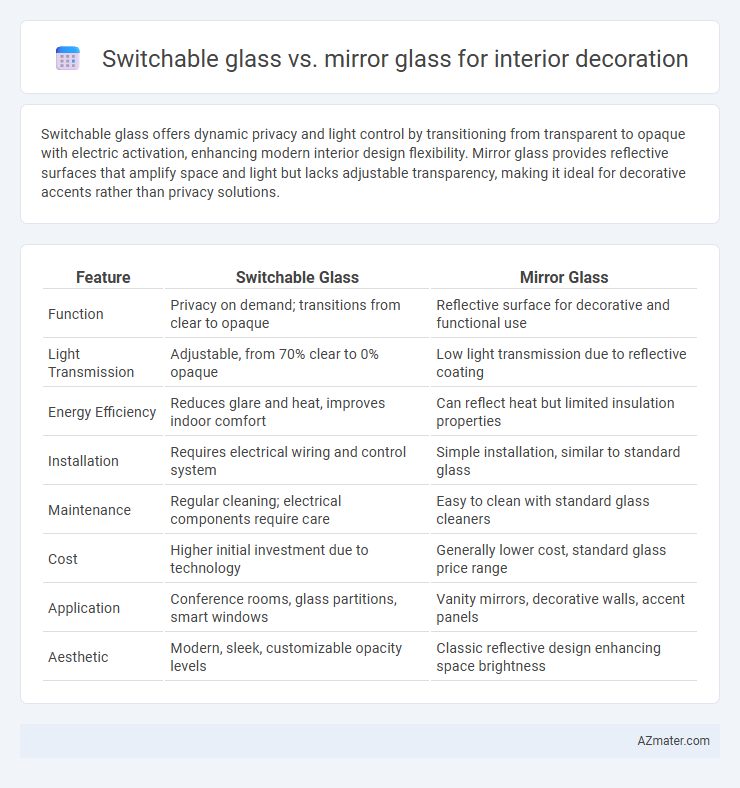Switchable glass offers dynamic privacy and light control by transitioning from transparent to opaque with electric activation, enhancing modern interior design flexibility. Mirror glass provides reflective surfaces that amplify space and light but lacks adjustable transparency, making it ideal for decorative accents rather than privacy solutions.
Table of Comparison
| Feature | Switchable Glass | Mirror Glass |
|---|---|---|
| Function | Privacy on demand; transitions from clear to opaque | Reflective surface for decorative and functional use |
| Light Transmission | Adjustable, from 70% clear to 0% opaque | Low light transmission due to reflective coating |
| Energy Efficiency | Reduces glare and heat, improves indoor comfort | Can reflect heat but limited insulation properties |
| Installation | Requires electrical wiring and control system | Simple installation, similar to standard glass |
| Maintenance | Regular cleaning; electrical components require care | Easy to clean with standard glass cleaners |
| Cost | Higher initial investment due to technology | Generally lower cost, standard glass price range |
| Application | Conference rooms, glass partitions, smart windows | Vanity mirrors, decorative walls, accent panels |
| Aesthetic | Modern, sleek, customizable opacity levels | Classic reflective design enhancing space brightness |
Introduction to Switchable Glass and Mirror Glass
Switchable glass features electrochromic technology that allows it to change from transparent to opaque with the flick of a switch, enhancing privacy and light control in interior spaces. Mirror glass provides reflective surfaces that increase light diffusion and create illusions of space, commonly used for decorative and functional purposes. Both materials offer unique aesthetic and practical benefits, making them popular choices for modern interior decoration.
Key Features of Switchable Glass
Switchable glass offers dynamic transparency control, transitioning from opaque to clear with an electric current, enhancing privacy and light management in interior spaces. It is energy-efficient, reducing the need for additional window treatments, and provides a sleek, modern aesthetic ideal for offices, conference rooms, and residential partitions. Unlike mirror glass, which reflects light and creates visual depth, switchable glass uniquely combines functionality and style by adapting to user preferences instantly.
Distinct Advantages of Mirror Glass
Mirror glass offers distinctive advantages for interior decoration, including enhanced light reflection that can make spaces appear larger and brighter. Its reflective surface adds a luxurious and elegant touch, creating focal points and visually expanding rooms without the need for additional lighting. Unlike switchable glass, mirror glass requires no electrical power, ensuring consistent performance and lower maintenance costs over time.
Aesthetic Appeal: Design Versatility Compared
Switchable glass offers dynamic aesthetic appeal by enabling seamless transitions between transparent and opaque states, providing privacy without sacrificing natural light, ideal for modern, minimalist interiors. Mirror glass enhances design versatility through reflective surfaces that amplify space perception and add a decorative touch suitable for both contemporary and classic themes. Choosing between switchable glass and mirror glass depends on functional needs and desired visual impact, with switchable glass emphasizing adaptability and mirror glass focusing on spatial enhancement.
Light Control and Privacy Solutions
Switchable glass offers dynamic light control by electronically toggling between transparent and opaque states, providing instant privacy and reducing glare while maintaining natural daylight. Mirror glass reflects light to enhance room brightness and adds privacy by limiting visibility from one side, but it does not offer adjustable opacity. For interior decoration, switchable glass provides versatile privacy solutions with seamless light modulation, whereas mirror glass primarily serves static light reflection and one-way privacy needs.
Energy Efficiency and Smart Home Integration
Switchable glass enhances energy efficiency by dynamically controlling light and heat transmission, reducing reliance on artificial lighting and HVAC systems. Mirror glass offers limited energy benefits but excels in aesthetic appeal and privacy within interior spaces. Smart home integration favors switchable glass for its ability to adapt opacity via app or voice control, seamlessly blending functionality with modern automation systems.
Maintenance and Durability Differences
Switchable glass features an electrochromic film that requires careful electrical maintenance to ensure consistent performance, while mirror glass demands regular cleaning to prevent surface degradation and loss of reflectivity. Switchable glass durability depends on the quality of the encapsulation, protecting the conductive layers from moisture and mechanical damage, whereas mirror glass is prone to scratching and can suffer from backing corrosion if not properly sealed. Both materials require specific upkeep routines, but switchable glass offers enhanced longevity in high-humidity environments compared to traditional mirror glass.
Installation Requirements and Costs
Switchable glass requires electrical wiring and a compatible power source for installation, often increasing complexity and cost compared to mirror glass, which only needs standard framing and mounting. The installation of switchable glass involves specialized labor to ensure proper functionality of its smart technology, typically costing 30-50% more than mirror glass. Mirror glass offers a more straightforward and budget-friendly installation with minimal technical requirements, making it a cost-effective choice for interior decoration.
Popular Interior Applications
Switchable glass enhances privacy and versatility in interior spaces such as conference rooms, hotels, and bathrooms by changing from opaque to transparent at the touch of a button. Mirror glass offers reflective surfaces ideal for bedrooms, gyms, and dressing rooms, adding depth and light without obstructing views. Both materials cater to modern design trends by integrating functionality and aesthetics in office partitions, spa areas, and residential interiors.
Choosing the Right Glass for Modern Interiors
Switchable glass offers dynamic privacy control by transitioning from transparent to opaque with electric activation, making it ideal for flexible spaces in modern interiors. Mirror glass enhances aesthetics and spatial perception by reflecting light and creating the illusion of larger rooms, suitable for decorative purposes. Selecting the right glass depends on the desired functionality--privacy and adaptability favor switchable glass, while visual expansion and style lean towards mirror glass.

Infographic: Switchable glass vs Mirror glass for Interior decoration
 azmater.com
azmater.com